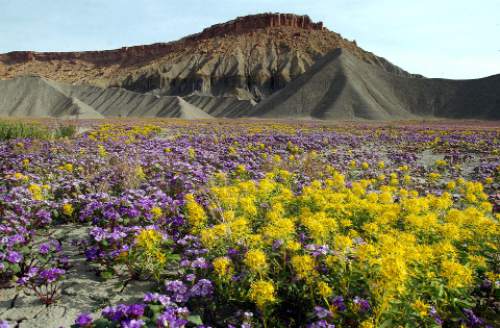This is an archived article that was published on sltrib.com in 2016, and information in the article may be outdated. It is provided only for personal research purposes and may not be reprinted.
Utah trust-lands officials plan to authorize construction of a gravel pit just east of the Wayne County hamlet of Teasdale, but many nearby residents contend such a use is a poor fit in an area famed for its bucolic and redrock vistas, potentially undermining its ability to attract visitors and support agriculture.
The proposal has sparked a lively debate on social media, and critics and supporters of the project converged at a planning commission hearing Wednesday night in Loa, where commissioners weighed a zoning change that would allow industrial uses in the scenic area largely devoted to livestock and alfalfa operations.
Supporters of the change talked about living near another pit without issue, while critics of the plan enumerated concerns about how it might impact tourism, health and safety. The zoning committee postponed a decision for another two weeks.
Some residents and business owners in Teasdale and Torrey have hard questions for Brown Brothers Construction Co., the longtime Loa firm that intends to excavate materials for road projects, and the Utah School and Institutional Trust Lands Administration (SITLA), which owns the land. How much truck traffic would the mine generate? How would dust be controlled? Where would Brown get its water? How many jobs would be created? How long would it operate and how would the site be reclaimed?
"Anything that involves tourism and events will be significantly impacted. ... Does this location fit with the general plan the county has for land use? As citizens of this county, what do we gain from this?" asked Dave Van Dyke, a lawyer who operates the Red River Lodge a couple of miles to the west and a farm immediately to the east of the site. He holds a SITLA grazing permit on the land that would be mined.
Teasdale sits on the windswept divide between Wayne County's political center in Loa and its tourism base to the east in Torrey, an artsy gateway to Capitol Reef National Park. Flowing through all these communities is the Fremont River.
Brown, which has operated a gravel pit on state land near Loa for decades, recently approached SITLA about leasing an L-shaped 120-acre parcel not far from the river, south of State Route 24. Brown wants to work 30 acres off the Teasdale Bench Road.
SITLA would charge annual rent of $1,200 and a royalty of 70 cents per cubic yard of material removed, according to Andy Bedingfield, a minerals specialist with SITLA, which deposits proceeds from resource extraction into an endowment supporting schools.
"We feel it a duty as a business and also a member of a great community to bring in revenue and jobs to our area," Brown said on its Facebook page. "If we are going to continue promoting tourism in our area, the need to update and expand infrastructure is critical."
Some are skeptical.
"I don't think it will create many jobs if they are shutting down their existing operation [near Loa]. You're just maintaining the ones you already have," said Van Dyke, who is concerned a gravel pit could actually derail jobs if it scares off big events such as Tour of Utah.
SITLA is proposing another gravel operation on 240 acres south of Hanksville about 50 miles to the east.
Sand and gravel are not the most lucrative minerals, but Utah pits did produce 27 million tons in 2013, at a value of $182 million, according to the Utah Geological Survey. The material is vital for supporting construction and is usually mined not far from where it is used.
But conflicts arise when operations are located near residential areas as seen with a number of pits along the Wasatch Front.
Utah Physicians for a Healthy Environment is urging county officials to reject Brown's proposal, in part because its location is subject to persistent winds from the west that would blow fugitive dust toward Torrey.
"Wind greater than 10 mph is enough to pick up dust from disturbed, raw land surfaces like gravel pits. Dust kicked up from mining operations can travel hundreds of miles. But the proximity to existing and future residents of nearby towns make the proposed gravel pit site an unacceptable health hazard," the group's president, Brian Moench, wrote in a letter.
Any gravel operation would require permitting from the Utah Department of Environmental Quality and Brown would have to develop a plan for minimizing dust, according to SITLA.
The county planning commission said it would issue a decision at its next meeting April and will accept written comments through Friday. Brown's proposal also requires a conditional-use permit. Its decision serve as a recommendation to the Wayne County Commission, which would make the final call.
Brown pledged to continue being a good community partner and neighbor.
"As our work history reflects, we will take every precaution to protect the land in a lawful, prudent, and good workmanlike manner. We will avoid unnecessary damage and injury to the surface or underlying estate and will not commit damage and wastage of other natural resources. We recognize the beauty our community holds, and take pride in doing everything possible to promote growth in our community and allow the masses to enjoy what we revel in each day," it said in a Facebook post.
Brian Maffly covers public lands for The Salt Lake Tribune. Maffly can be reached at bmaffly@sltrib.com or 801-257-8713. Twitter: @brianmaffly



